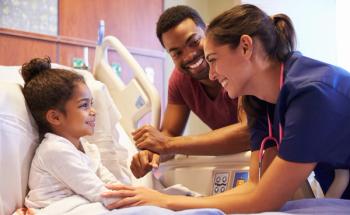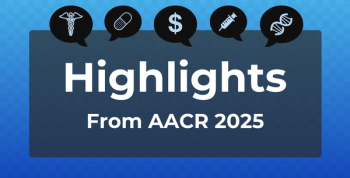
Dr Christopher Flowers Discusses Second-Line Therapies for B-Cell Lymphomas
There are various immunotherapies being used in the second ling for patients with lymphomas, some of which have curative potential, explained Christopher Flowers, MD, MS, of the University of Texas MD Anderson Cancer Center.
Historically autologous stem cell transplantation (ASCT) has been the standard of care for patients with B-cell lymphoma who relapse, but new data has shown chimeric antigen receptor (CAR) T-cell therapy has advantages of ASCT, explained Christopher Flowers, MD, MS, professor and chair of the Department of Lymphoma Myeloma at the University of Texas MD Anderson Cancer Center.
CAR T-cell therapy is potentially curative for these patients, but those at high risk of relapse need to be identified quickly for treatment, he said.
In an interview with The American Journal of Managed Care® (AJMC®), Flowers discussed various forms of immunotherapy being used for patients with lymphomas, timing for starting second-line therapies, and emerging therapies to use for second-ling treatment.
AJMC: What second-line B-cell lymphoma therapies are available for patients after the first line?
Flowers: When we think about second-line therapy for diffuse large B-cell lymphoma, historically, ASCT had been the primary curative option for patients with relapse after standard R-CHOP (rituximab, cyclophosphamide, doxorubicin hydrochloride, vincristine [Oncovin], and prednisone) therapy. Relatively recently, we now have data showing that for patients who have primary refractory disease, or who have early relapse within 12 months, that CAR T-cell therapy is preferred over ASCT and offers a treatment option with curative potential for those patients. Most recently, there are follow-up data from one study on one of those CAR T cell products—axicabtagene ciloleucel—that shows there is an overall survival advantage for patients who received CAR T cells when compared with standard of care.
For patients who have later relapse of their disease after 12 months, ASCT remains a curative option. For patients who are not candidates for ASCT or not candidates for CAR T-cell therapy, there are other approaches that are available with chemoimmunotherapy or with targeted therapies alone or in combination with other therapies. Most recently, bispecific antibodies have been approved for the second or later line of therapy in several countries.
I think what is also important to note is now with the new data showing polatuzumab plus R-CHP provides a progression-free survival advantage over R-CHOP in the frontline that we may see additional changes in second-line therapy after that.
AJMC: What are the potential benefits and drawbacks of using immunotherapy in the second-line setting?
Flowers: There are various forms of immunotherapy used for patients with lymphomas. As we think about immunotherapy and solid tumors, that's thought of as a very novel concept. But immunotherapies go back to the 1990s for patients with lymphomas, with rituximab and anti-CD20 targeted antibody therapy being approved and available from that time to the present. This treatment is now a very comfortable form of immunotherapy that's been standard treatment in first line and second line with diffuse large B-cell lymphoma. We now have other forms of immunotherapy—what I will call immunotherapies with cells, using CAR T-cell therapies and immunotherapy with antibodies that pull in immune cells.
Some of the challenges with both approaches have been new sorts of toxicities like cytokine release syndrome and neurologic toxicity that is associated with these treatments. These therapies often require hospitalization that sometimes can involve prolonged hospitalization to be able to manage those toxicities.
Other forms of immunotherapy that have recently emerged and are now approved for use in patients with large cell lymphoma in the second or later line of therapy include bispecific antibodies. These are antibodies that engage both the patient's T cells and the lymphoma cells to bring that immune system there to attack the cells. Those also can be associated with cytokine release syndrome and neurological toxicities in some settings.
AJMC: How do you determine the optimal timing for initiating second-line therapies?
Flowers: As I mentioned, for those patients who have disease that is refractory to first-line therapy or who have early relapse within 12 months, CAR T-cell therapy, right now, is a potentially curative option for those patients and has been shown in 2 randomized controlled trials to provide benefits over the prior standard of care. And so that would be a preferred therapy with that optimal timing. For patients who have later relapse of disease, ASCT remains the standard approach for patients with chemosensitive disease.
I think one of the things that is important in all of those settings is for the physician who identifies a patient who may be at risk for relapse, that those patients are evaluated rapidly and sent to centers where cell therapies can be administered.
AJMC: Are there any emerging or investigational therapies showing promise in the second-line treatment of B-cell lymphoma?
Flowers: I've mentioned the role of CAR T-cell therapy—the CAR T cells that I'm now talking about there are CD19-directed CAR T cells. Those are all approved products for patients with relapsed DLBCL. There are other targets for CAR T cells. These include CD79B, a target that looks promising. CD70 is also a promising target for large cell lymphomas, and there other promising targets. Clinical trials are now open and enrolling patients using cellular therapies directed at these lymphoma targets. All the CAR T cells that I mentioned so far are autologous CAR T cells with the patient's own cells; allogeneic CAR T cells are another option. CAR therapies using natural killer cells also appear promising.
The other therapy that has been an investigational therapy until very recently are the bispecific antibodies that target both the T cells and target the lymphoma cells. There are bispecific antibodies that are approved and now and others that are being looked at as investigational therapies still.
AJMC: What are you working on in the management of B-cell lymphoma that you are excited to share?
Flowers: I think there are a number of really exciting things in diffuse large B-cell lymphoma currently. All of the investigational therapies that I mentioned are therapies that are under evaluation in clinical trials at MD Anderson. The other things that I find extraordinarily exciting is work led by my colleague, Jason Westin, MD. Last year, he published work on our Smart Start study, that is using novel agents in the frontline, prior to giving chemotherapy for diffuse large B-cell lymphoma. He has a follow-up trial called Smart Stop that is looking at chemotherapy-free options for patients with diffuse large B-cell lymphoma that is now enrolling patients on trial. We're looking at those kinds of combinations both in the frontline and in the relapse setting.
And the other area of work that is quite exciting is the use of minimal residual disease evaluation with cell-free DNA that can help to predict patients who may need additional therapy and patients who are much more highly likely to be cured. And then the final thing that I'll mention is the role of molecular profiling using whole exome sequencing, RNA seq and copy number to be able to identify subsets of large B-cell lymphoma who may be more appropriately treated with specific targeted agents.
Newsletter
Stay ahead of policy, cost, and value—subscribe to AJMC for expert insights at the intersection of clinical care and health economics.









































